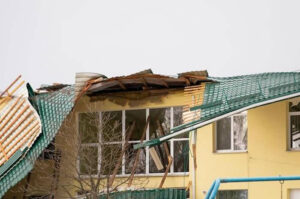Roof Damage
 When you live in a home that’s been around for a while, it’s common to start noticing some wear and tear. Your roof might be showing signs of deterioration, or maybe there are cracks in your siding or other damage. It can be a little scary when this happens, but luckily, we’re here to help!
When you live in a home that’s been around for a while, it’s common to start noticing some wear and tear. Your roof might be showing signs of deterioration, or maybe there are cracks in your siding or other damage. It can be a little scary when this happens, but luckily, we’re here to help!
This blog post will talk about some of the most common factors that cause roof damage, as well as what you can do about them.
1. Wind
Wind can cause damage to roofs in a variety of ways. The most obvious are heavy winds that blow shingles off your roof, but there are also more subtle effects. For example, wind can cause moisture buildup in your attic and attic ventilation systems, leading to mold and mildew growth.
However, keep in mind that wind is not always the culprit when it comes to roof damage; hail and snow accumulation can be just as damaging if left unchecked by a homeowner or property manager who doesn’t know how to prevent it from happening.
2. Hail
Hail results from supercooled water droplets in a cloud, freezing and falling to the ground. This can happen when there is an updraft, causing the hailstone to grow through accretion. The hailstone then falls out of the cloud when it loses its buoyancy.
Hailstones are composed of ice crystals compressed by their weight and collisions with other falling hailstones. They do not melt upon impact with Earth’s surface because they have been exposed to temperatures below freezing for too long for any measurable liquid water content.
3. Florida Sun
Over time with the intensity of the Florida sunshine and particularly with asphalt shingle roofs, the heat takes a toll on the material, drying it out and begins to get brittle and easily damaged.
4. Heavy Snow (for snow birds!)
Snow can weigh down on your roof and eventually cause structural damage, or it can melt and seep through the roof, causing more problems than just water damage.
Ice dams are another common problem caused by snow. When ice builds up at the eaves of your home’s exterior walls, it creates an insulating barrier between the house and its surroundings, preventing warm air from escaping into winter weather below zero degrees Fahrenheit (-18 Celsius). This leads to condensation within the insulation layer between these two areas–and before you know it, you’ve got leaking pipes or ceiling mold!
5. Ice Dams (for snow birds!)
Ice dams are a common cause of roof damage. Ice dams form when water freezes on the roof and then melts but doesn’t run off. Instead, it builds up under your shingles and causes them to sag or buckle. If you don’t address this issue quickly, ice dam damage can lead to serious problems like leaks and even collapse–not something you want happening during wintertime!
To prevent ice dam formation:
- Keep your gutters clean so they function properly to remove excess water from your home’s exterior (and prevent flooding).
- Clear snow off all flat surfaces around windows and doors so they don’t trap snow drifts against them–this can cause moisture buildup within those areas that could lead to mold growth later on down the road if not taken care of right away; plus, it’ll keep drafts down inside during colder months too!
Get Your Inspection
If you’re concerned about your roof’s condition, it’s important to have it inspected by a professional. This will allow you to identify any issues early on and address them before they become more serious.
At Handy Home Inspector, we specialize in home inspections and can provide the information you need to decide whether your home needs repairs. Schedule an appointment today.

Recent Comments